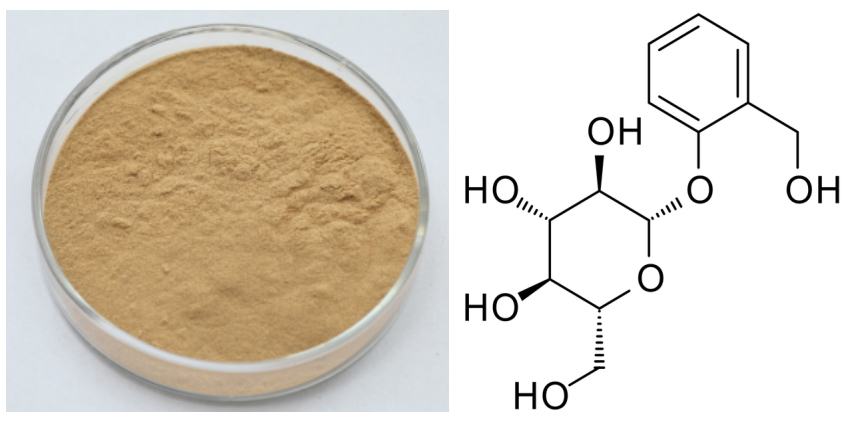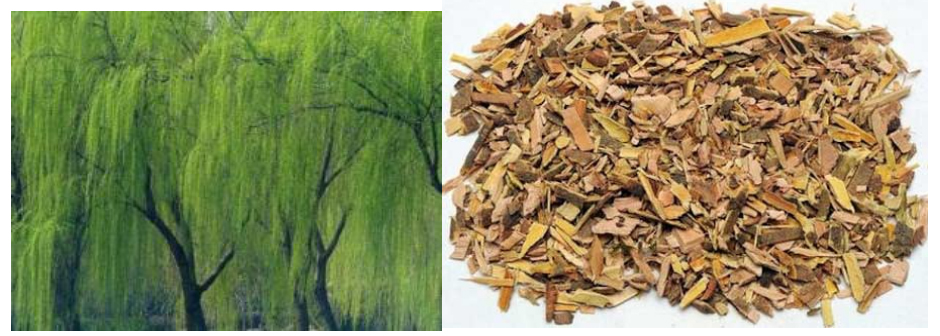15 Years Manufacturer White Willow Bark Extract Factory from Grenada
15 Years Manufacturer White Willow Bark Extract Factory from Grenada Detail:
[Latin Name] Salix alba L.
[Plant Source] from China
[Specifications] Salicin 15-98%
[Appearance] Yellow Brown to White powder
Plant Part Used: Bark
[Particle size] 80 Mesh
[Loss on drying] ≤5.0%
[Heavy Metal] ≤10PPM
[Storage] Store in cool & dry area, keep away from the direct light and heat.
[Shelf life] 24 Months
[Package] Packed in paper-drums and two plastic-bags inside.
[Net weight] 25kgs/drum
Brief Introduction
Salicin is a naturally occurring compound found in the bark of several species of trees, primarily North American in origin, that are from the willow, poplar, and aspen families. White willow, from whose Latin name, Salix alba, the term salicin is derived, is the most well known source of this compound, but it is found in a number of other trees, shrubs, and herbaceous plants as well being synthesized commercially. It is a member of the glucoside family of chemicals and is used as an analgesic and antipyretic. Salicin is used as a precursor for the synthesis of salicylic acid and acetylsalicylic acid, commonly known as aspirin.
A colorless, crystalline solid in its pure form, salicin has the chemical formula C13H18O7. Part of its chemical structure is equivalent to the sugar glucose, meaning it is classified as a glucoside. It is soluble, but not strongly so, in water and alcolhol. Salicin has a bitter taste and is a natural analgesic and antipyretic, or fever reducer. In large quantities, it can be toxic, and overdoses may lead to liver and kidney damage. In its raw form, it may be mildly irritating to skin, respiratory organs, and eyes.
Function
1. Salicin is used to ease pain and reduce inflammation.
2. Relieve acute and chronic pain, including headache, back and neck pain, muscle aches, and menstrual cramps; Control arthritis discomforts.
3. Relieve acute and chronic pain.
4. It has the same effect on the body as aspirin without any of the side effects.
5. It is an anti-inflammatory, a fever reducer, an analgesic, an anti-rheumatic, and an astringent. Specifically, it helps to relieve headaches.
Application
1.Anti-inflammatory, anti-rheumatic,
2.Reduce a fever,
3.Use as an analgesic and astringent,
4.Relieve headache,
5.Ease pain caused by rheumatism, arthritis, and carpal tunnel syndrome.
Product detail pictures:

Related Product Guide:
We're commitment to offer you the aggressive cost ,superb products and solutions top quality, too as fast delivery for 15 Years Manufacturer White Willow Bark Extract Factory from Grenada , The product will supply to all over the world, such as: Anguilla, Vancouver, Cairo, Thus far, our item associated with printer dtg a4 may be shown in most foreign nations as well as urban centers, which are sought after simply by targeted traffic. We all highly imagine that now we have now the full capacity to present you with contented merchandise. Desire to collect requests of your stuff and produce the long-term co-operation partnership. We very seriously promise:Csame top quality, better price; exact same selling price, higher quality.
Well i recorded this one ages ago and i just thought that i would upload it now.
It’s about a recyclable plastic really.
But it is also something that i personally use quite a lot and have done for binders in Batteries for example.
It really works well as a conductive plastic with an addition of lets say Graphite. But it is very flexible on Acetates to.
And it is waterproof, fairly heat resistant so can be used as a paint or ink or whatever.
You can also obviously change the conductivity at will.
Inle Lake is a freshwater lake in the Shan State. It is the second largest lake in Myanmar with an estimated surface area of 44.9 square miles (116 km2), and one of the highest at an elevation of 2,900 feet (880 m). During the dry season, the average water depth is 7 feet (2.1 m), with the deepest point being 12 feet (3.7 m), but during the rainy season this can increase by 5 feet (1.5 m).
The lake is known for its floating markets that rotate around between villages.
Village of Nampan is situated to the south of Ywama village. The whole village is situated on the stilts over the water, which is a traditional way of building houses in Inle Lake. The Oldest pagoda in Inle Lake, Alodaw Pauk Pagoda, is situated in Nampan.
The village of Inphaw Khone, situated to the west of Nampan village, is famous for its traditional weaving workshops. One of the specialty products of Inphaw Khone village is the famous lotus-silk shawl. The delicate fiber strands from lotus shoot were carefully extracted to make strings for the shawl. The process of fiber string extraction from lotus shoot is a tedious and time consuming as well as expensive process. As a result, the shawls made of lotus-silk are very expensive – cost a minimum of US$ 30 for a small shawl. Apart from famous lotus-silk shawl, Inphaw Khone also produce a large quantity of silk and cotton fabric.
The other tourist trap sort of places visited on the trip included a silver smith and a cigar/cigarette maker…
North of Nampan are these famous gardens, where Intha farmers grow flowers, tomatoes, squash and other fruit and vegetables on long wooden trellises supported on floating mats of vegetation. In the morning and afternoon, farmers paddle up and down between the rows tending their crops.
On the western side of the lake, the Nga Hpe Kyaung (Jumping Cat Monastery) is famous for its jumping cats, trained to leap through hoops during the slow hours between scripture recitals. However, my hotel receptionist said: “No more jumping cats. The old monks who trained them died. Now they are just sleeping cats…”
Since I was joined by a British girl from my hotel and her Mexican/Danish friend who lives in Denmark, the trip was 6k (US$6) instead of 18k but then the boatman said he was only getting 10k or something and that its cheaper to negotiate directly with a boat man.
We are really happy to find such a manufacturer that ensuring product quality at the same time the price is very cheap.






